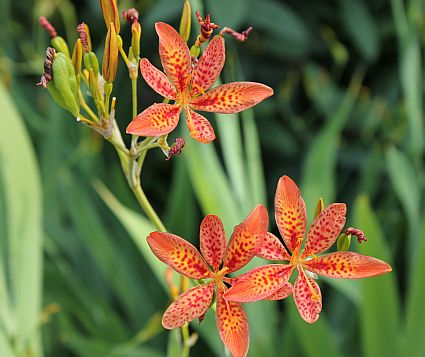A bit more on my recent travels to the big floriculture conference in Columbus, Ohio. I always try to make it out to the Chadwick Arboretum & Learning Gardens, on the campus of THE Ohio State University. There are several components, including trials, a large arboretum, and several small gardens. My favorite is the Steven Still Perennial Garden. It’s a lovely mixed garden, designed by Adrian Bloom (Blooms of Bressingham), and was installed in ONE DAY by their garden volunteers – 2005, I think.
Watching it grow has been fun. I noted [ with pleasure] that they’ve already had to start cutting back and removing some things. This makes me feel better because I am The Queen of Planting Too Close
A few highlights:
I thought of y’all when I saw
this…remember our conversation about Stachys the other day? Here’s a
new one on me: Stachys byzantina ‘Silky Fleece’. What teeny, tiny
little leaves! And seemed to be limiting itself to a small area on the
edge of the border. Introduced in 2006 by German seedmeisters Jelitto
Perennial Seeds. They missed the boat on naming it…could have all kind
of fun with ‘Little Lamb’ or even ‘Mary’s Little Lamb’ as the director
for their North American office is Mary Vaananen. Heh.

My foot is just in there for scale – I’m really not that inept a
photographer.

A gorgeous flock of Rhus typhina ‘Tiger Eyes’. Hardy to Zone 4, the foliage is golden in summer, blazing apricot in fall, a wonderful shrub accent in any garden… What? Hang on a sec.
Correction:
That’s Rhus typhina ‘Bailtiger’ PP16,185. Trade name is First Editions® Tiger Eyes® Cutleaf Staghorn Sumac. Well, that took all the fun out of it.
Moving on…

Belamcanda chinensis – Blackberry or Leopard
Lily. A tough cookie, this midseason bloomer takes drought and even
reseeds a little bit in my home garden. The pods burst open to
reveal a cluster of seeds that look exactly like a blackberry. These
weren’t quite that far along, but in between flowering and seed setting, they
do something else interesting..

The petals twist up into these hilarious
little bundles. I have no idea why or what for. Just kind of neat.
All for now!


















